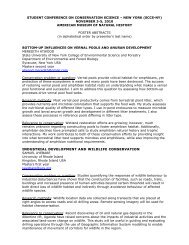SRMP Dynamic Earth Curriculum - American Museum of Natural ...
SRMP Dynamic Earth Curriculum - American Museum of Natural ...
SRMP Dynamic Earth Curriculum - American Museum of Natural ...
You also want an ePaper? Increase the reach of your titles
YUMPU automatically turns print PDFs into web optimized ePapers that Google loves.
Science Research Mentoring Program<strong>Dynamic</strong> <strong>Earth</strong>Session Five: Geologic TimeACTIVITY: Ages <strong>of</strong> Rocks Part 2 – Absolute AgesBefore class: Use the Heilbrunn Cosmic Pathway to measure the distance from the formation <strong>of</strong>the <strong>Earth</strong> to the present with a long rope (or use another length appropriate to the history <strong>of</strong> <strong>Earth</strong>).Label one end “the present” and the other “formation <strong>of</strong> <strong>Earth</strong>.”In class: Break the class into no more than 10 groups. Assign each one a rock from the list above;hand out appropriate slips <strong>of</strong> paper. Explain to students that the long rope represents the wholehistory <strong>of</strong> the <strong>Earth</strong>, and remind them that <strong>Earth</strong> is 4.567 billion years old. Students should tape theirrock to the rope at the “time” it was formed.It will help for students to work in order, from youngest rock to oldest, or vice versa. Once all groupshave taped their rock names to the rope, quickly review the placements. Ask if anyone disagreeswith any <strong>of</strong> the placements.Carefully remove the rope from the wall <strong>of</strong> the class, and take it to the Heilbrunn Cosmic Pathway.Place the rope along the pathway. Starting with the formation <strong>of</strong> <strong>Earth</strong> (look backwards to see theoldest meteorite), compare the estimated ages <strong>of</strong> rocks to the ages posted on the pathway. Makeadjustments as necessary, and discuss along the way. At the end <strong>of</strong> the rope (the present), challengestudents to consider the depth <strong>of</strong> geologic time.Gather up the rope and return to the classroom.If the Heilbrunn Cosmic Pathway is not available, any long hallway will work. Find the ages <strong>of</strong> therocks, measure out the appropriate length <strong>of</strong> the hall (ratio <strong>of</strong> age <strong>of</strong> <strong>Earth</strong> to length <strong>of</strong> hall equalsage <strong>of</strong> rock to distance in hall) and place markers at the appropriate intervals for each rock. This canserve as the “answer key” in place <strong>of</strong> the Heilbrunn Cosmic Pathway.© 2013 <strong>American</strong> <strong>Museum</strong> <strong>of</strong> <strong>Natural</strong> History. All Rights Reserved. 27
















